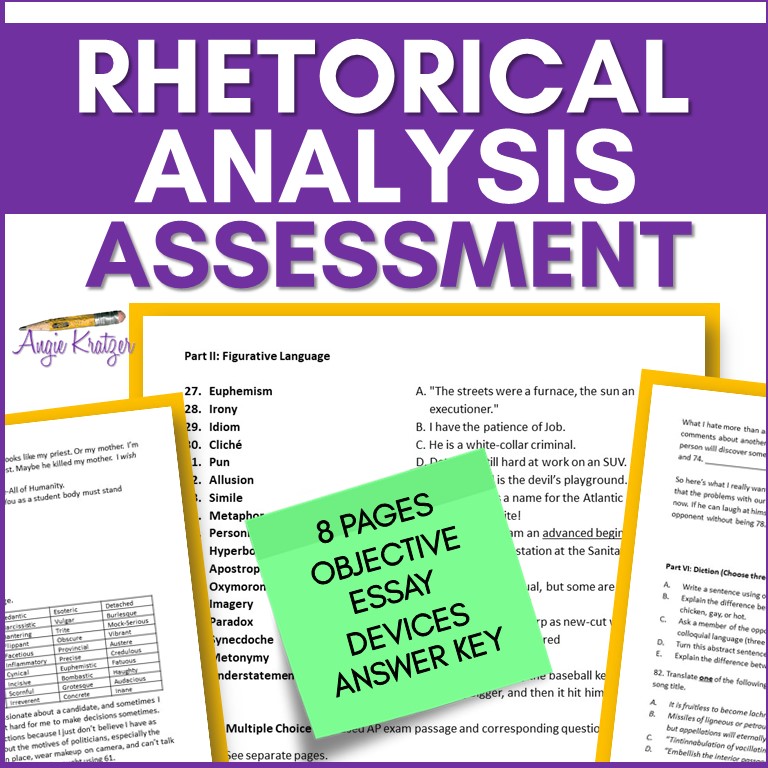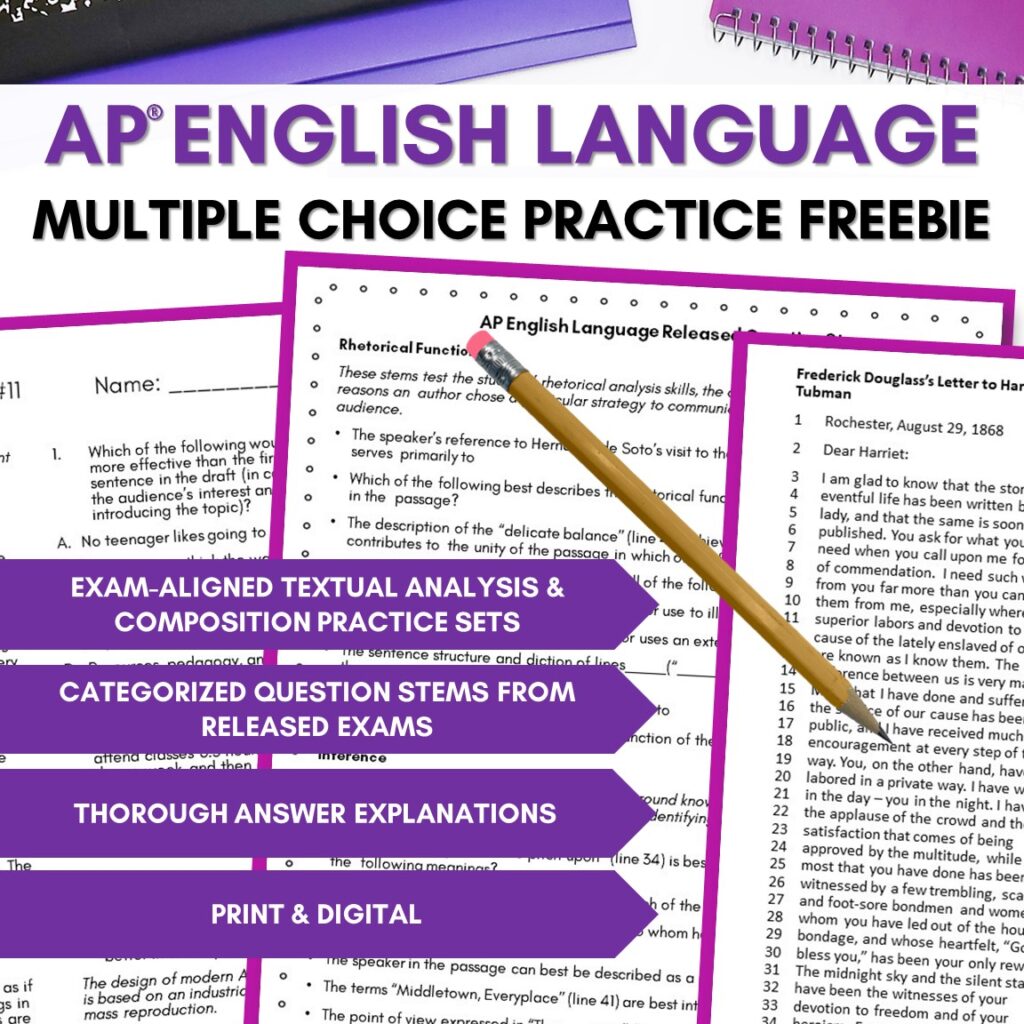If your school or district requires a summative mid-term or final exam of some sort for an AP English Language & Composition class, you have to weigh a few things:
What is my goal?
How much grading am I willing to do?
How long do I have to have to turn around the student products?
There are numerous options if you have full autonomy over the design. Because I spend first semester on rhetorical analysis, my exam is focused there.

Option 1: Give a full AP Language exam.
Give all three essays (synthesis, rhetorical analysis, and argument) and a full multiple choice practice (45 questions or so).
Advantages: If you’re on the semester system and have hit all the skills you need to hit, you can treat the exam as a mock test and get an idea of how your students might do on the May exam.
Disadvantages: The grading load! One way to manage the scoring is to have students at the end of the exam period choose the one essay they want evaluated. That one goes on top with a student-friendly rubric. That way, they have had the time management practice but are able to highlight what they can do well.
Option 2: Allow student choice on the mid-term mode (from the AP Language exam).
If the goal is to see what your skills they have mastered, let students show off by choosing the prompt they want. Give all three types from released exams and let them pick the one to which they will respond. You might do this with class consensus or let individual students choose.
Advantage: Student choice! They get to have a sense of control and even ownership of their own knowledge and how to demonstrate it.
Disadvantage: If you go the individual choice route, you’re looking at calibrating your scoring against the exemplars for three different prompts. That’s pretty time consuming.
Option 3: Focus on specific AP Language writing and analysis skills.
If you’re on a year-long schedule and have the freedom to give a formative exam to help you plan for next semester, consider a more skill-specific tool. The advantages are twofold: You’re getting to the heart of the matter (skills on which you have focused) and saving some grading.
Students might do a combination of these exercises:
*Read a prompt, outline a response, and write the thesis statement and topic sentences only.
*Read a prompt, complete SOAPS or SPACECAT (or whatever kooky acronym your students have concocted), and write a thesis.
*Annotate one prompt only and write a thesis.
*Do mini analyses of shorter passages. This could come in the form of short excerpts from letters or speeches, for which students will write one-paragraph responses.
* Give one analysis multiple choice practice and one composition multiple choice practice for a total of 20ish questions.
*If you’ve worked on question design, give a short passage and have students write one or two multiple choice questions for it. You can read more about question design here.
*Give students a short essay to read and have them write a rhetorical analysis prompt for the passage.
Option 4: Use the time for the culmination of an AP Lang unit.
Is the class is wrapping up a unit on a longer work, like a memoir? Pull from the book and have students write a rhetorical analysis or argument based on the content. If you were able to squeeze in some fiction just before the exam, pull a speech or letter from the novel and analyze it.
Option 5: Demonstrate skills and processes through revision.
I really like this option. I saw the suggestion in an AP Lang Facebook group, so credit and thanks are due to Karen Cardenas.
If you’re keeping a writing portfolio for each student (and I hope you are–even an organized digital folder), ask students to pull their weakest rhetorical analysis essay (or argument or synthesis depending on how you’ve designed your course). That student rewrites the essay in order to demonstrate growth. One option is to have students write a separate piece defending the revision choices they made. That document could even be bulleted or written on sticky notes on the essay itself.
Advantages: Students have choice and get to demonstrate how much they have grown in their understanding of the mode.
Disadvantages: You have to recalibrate on the exemplars if you decide to score the revisions. Modify by evaluating the revision notes instead of the actual response.
Option 6: Go objective.
Eons ago, my mid-term exam was a painful evaluation of their knowledge of terms that could apply to the AP Lang exam. The exam’s treatment of the minutia has gone away, but I still like my students to know what anaphora and loose sentences are. This is a free version of that exam if you have spent a lot of time on terminology. Pull from it if you need it!

Option 7: Weave in American Literature.
Here in North Carolina, we have to include a survey of American literature. It’s not impossible, but planning for a course like that requires some finesse with timing. Add to that formula an attempt to stay aligned with APUSH pacing, and it’s a challenge. Because American Lit is the framework for my course, I include it on my mid-term and final exams, and I try to keep it light and fun. Here’s how it looks:
- Part I: I give five to eight short passages from an American literature and have students identify what period each one came from. Be sure to choose passages that are exemplary, like a paragraph from “The Minister’s Black Veil” that illustrates the supernatural, dark, gothic description of the Romantic period.
- Part II: I create a list of characters and authors and ask students to write a dialogue between two of them about a specific topic. For example, Pecola Breedlove and Huck Finn might have a conversation about racism. Benjamin Franklin and Jason Reynolds might have a conversation about privilege. Give students ten pairs/topics to choose from. A way to differentiate and give more options might be to give students ists of characters, authors, and topics with instructions to create their own pairing.
Option 8: Use AI to generate questions for an AP Language mid-term exam.
After writing this post (just for the heck of it), I gave ChatGPT this prompt: “You are an AP English Language and Composition teacher, and you work with high school students. Write a mid-term exam that focuses on rhetorical analysis.”
OpenAI gave me one paragraph with five multiple choice questions and two prompts from which students could choose. The prompts, unfortunately, did not include passages; they were designed more like arguments about rhetorical analysis. It did give me the idea that two short, cold RA passages might do the trick.
So there you go! You have a whole pile of ideas for designing your mid-term exam for AP English Language & Composition. Let me know what worked for you!
Before you weigh in to the depth of timed multiple choice practice, grab this free set of stems and practice exercises.


